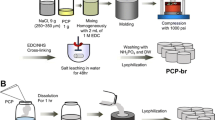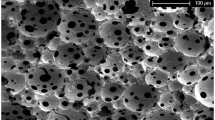Abstract
Chondrocytes are easily de-differentiated when cultured in monolayer, and tissue-engineered cartilage can be generated by seeding chondrocytes onto three-dimensional porous synthetic biodegradable polymers. In this study, we investigated the biochemical and molecular aspects of chondrocytes in a monolayer-culture system and selected the optimal subculture passages based on their de-differentiation. We also compared two commonly used synthetic biodegradable polymers, polylactide (PLA), and polylactic-co-glycolic acid (PLGA), for their suitability as scaffolds for artificial cartilage. De-differentiated chondrocytes were observed after two passages. These results suggested that the first cell passage was optimal for seeding as only a few chondrocytes secreted extracellular matrix components to form homogeneously compact cartilage. Substantially increased glycosaminoglycan and total collagen levels revealed that PLGA scaffolds were a better option for inducing cartilage tissue formation compared to the PLA scaffolds. Histological and immunohistochemical results showed that chondrocytes seeded into PLGA retained their morphological phenotype to a greater extent than those seeded into PLA.
Similar content being viewed by others

References
Hellio Le Graverand, M. P., C. Reno, and D. A. Hart (1998) Influence of pregnancy on gene expression in rabbit articular cartilage. Osteoarthr. Cartil. 6: 341–350.
Deng, Y., K. Zhao, X. F. Zhang, P. Hu, and G. Q. Chen (2002) Study on the three-dimensional proliferation of rabbit articular cartilage-derived chondrocytes on polyhydroxyalkanoate scaffolds. Biomaterials 23: 4049–4056.
Min, B. H., B. H. Choi, and S. R. Park (2007) Low intensity ultrasound as a supporter of cartilage regeneration and its engineering. Biotechnol. Bioprocess Eng. 12: 22–31.
Sahoo, S. K., A. K. Panda, and V. Labhasetwar (2005) Characterization of porous PLGA/PLA microparticles as a scaffold for three dimensional growth of breast cancer cells. Biomacromolecules 6: 1132–1139.
Rabiee, S. M., S. M. J. Mortazavi, F. Moztarzadeh, D. Sharifi, Sh. Sharifi, M. Solati-Hashjin, H. Salimi-Kenari, and D. Bizari (2008) Mechanical behavior of a new biphasic calcium phosphate bone graft. Biotechnol. Bioprocess Eng. 13: 204–209.
Taylor, M. S., A. U. Daniels, K. P. Andriano, and J. Heller (1994) Six bioabsorbable polymers: in vitro acute toxicity of accumulated degradation products. J. Appl. Biomater. 5: 151–157.
Bryan, D. J., A. H. Holway, K. K. Wang, A. E. Silva, D. J. Trantolo, D. Wise, and I. C. Summerhayes (2000) Influence of glial growth factor and Schwann cells in a bioresorbable guidance channel on peripheral nerve regeneration. Tissue Eng. 6: 129–138.
Evans, G. R., K. Brandt, M. S. Widmer, L. Lu, R. K. Meszlenyi, P. K. Gupta, A. G. Mikos, J. Hodges, J. Williams, A. Gürlek, A. Nabawi, R. Lohman, and C. W. Patrick (1999) In vivo evaluation of poly (L-lactic acid) porous conduits for peripheral nerve regeneration. Biomaterials 20: 1109–1115.
Hadlock, T., C. Sundback, D. Hunter, M. Cheney, and J. P. Vacanti (2000) A polymer foam conduit seeded with Schwann cells promotes guided peripheral nerve regeneration. Tissue Eng. 6: 119–127.
Calvert, J. W., W. C. Chua, N. A. Gharibjanian, S. Dhar, and G. R. Evans (2005) Osteoblastic phenotype expression of MC3T3-E1 cells cultured on polymer surfaces. Plast. Reconstr. Surg. 116: 567–576.
Benya, P. D. and J. D. Shaffer (1982) Dedifferentiated chondrocytes reexpress the differentiated collagen phenotype when cultured in agarose gels. Cell 30: 215–224.
Elima, K. and E. Vuorio (1989) Expression of mRNAs for collagens and other matrix components in dedifferentiating and redifferentiating human chondrocytes in culture. FEBS Lett. 258: 195–198.
Von der Mark, K., V. Gauss, H. von der Mark, and P. Müller (1977) Relationship between cell shape and type of collagen synthesised as chondrocytes lose their cartilage phenotype in culture. Nature 267: 531–532.
Kim, H., H. W. Kim, and H. Suh (2003) Sustained release of ascorbate-2-phosphate and dexamethasone from porous PLGA scaffolds for bone tissue engineering using mesenchymal stem cells. Biomaterials 24: 4671–4679.
Choi, Y. S., S. N. Park, and H. Suh (2005) Adipose tissue engineering using mesenchymal stem cells attached to injectable PLGA spheres. Biomaterials 26: 5855–5863.
Choi, Y. S., S. N. Park, and H. Suh (2008) The effect of PLGA sphere diameter on rabbit mesenchymal stem cells in adipose tissue engineering. J. Mater. Sci. Mater. Med. 19: 2165–2171.
Tullberg-Reinert, H. and G. Jundt (1999) In situ measurement of collagen synthesis by human bone cells with a sirius red-based colorimetric microassay: effects of transforming growth factor beta2 and ascorbic acid 2-phosphate. Histochem. Cell Biol. 112: 271–276.
Suh, H. and J. E. Lee (2002) Behavior of fibroblasts on a porous hyaluronic acid incorporated collagen matrix. Yonsei Med. J. 43: 193–202.
Habraken, W. J., J. G. Wolke, A. G. Mikos, and J. A. Jansen (2006) Injectable PLGA microsphere/calcium phosphate cements: physical properties and degradation characteristics. J. Biomater. Sci. Polym. Ed. 17: 1057–1074.
Shive, M. S. and J. M. Anderson (1997) Biodegradation and biocompatibility of PLA and PLGA microspheres. Adv. Drug Deliv. Rev. 28: 5–24.
Hou, Q., D. W. Grijpma, and J. Feijen (2003) Preparation of interconnected highly porous polymeric structures by a replication and freeze-drying process. J. Biomed. Mater. Res. 67: 732–740.
Sherwood, J. K., S. L. Riley, R. Palazzolo, S. C. Brown, D. C. Monkhouse, M. Coates, L. G. Griffith, L. K. Landeen, and A. Ratcliffe (2002) A three-dimensional osteochondral composite scaffold for articular cartilage repair. Biomaterials 23: 4739–4751.
Liu, R., S. S. Huang, Y. H. Wan, G. H. Ma, and Z. G. Su (2006) Preparation of insulin-loaded PLA/PLGA microcapsules by a novel membrane emulsification method and its release in vitro. Colloids Surf. 51: 30–38.
Author information
Authors and Affiliations
Corresponding authors
Rights and permissions
About this article
Cite this article
Lee, N.K., Oh, H.J., Hong, C.M. et al. Comparison of the synthetic biodegradable polymers, polylactide (PLA), and polylactic-co-glycolic acid (PLGA) as scaffolds for artificial cartilage. Biotechnol Bioproc E 14, 180–186 (2009). https://doi.org/10.1007/s12257-008-0208-z
Received:
Accepted:
Published:
Issue Date:
DOI: https://doi.org/10.1007/s12257-008-0208-z



